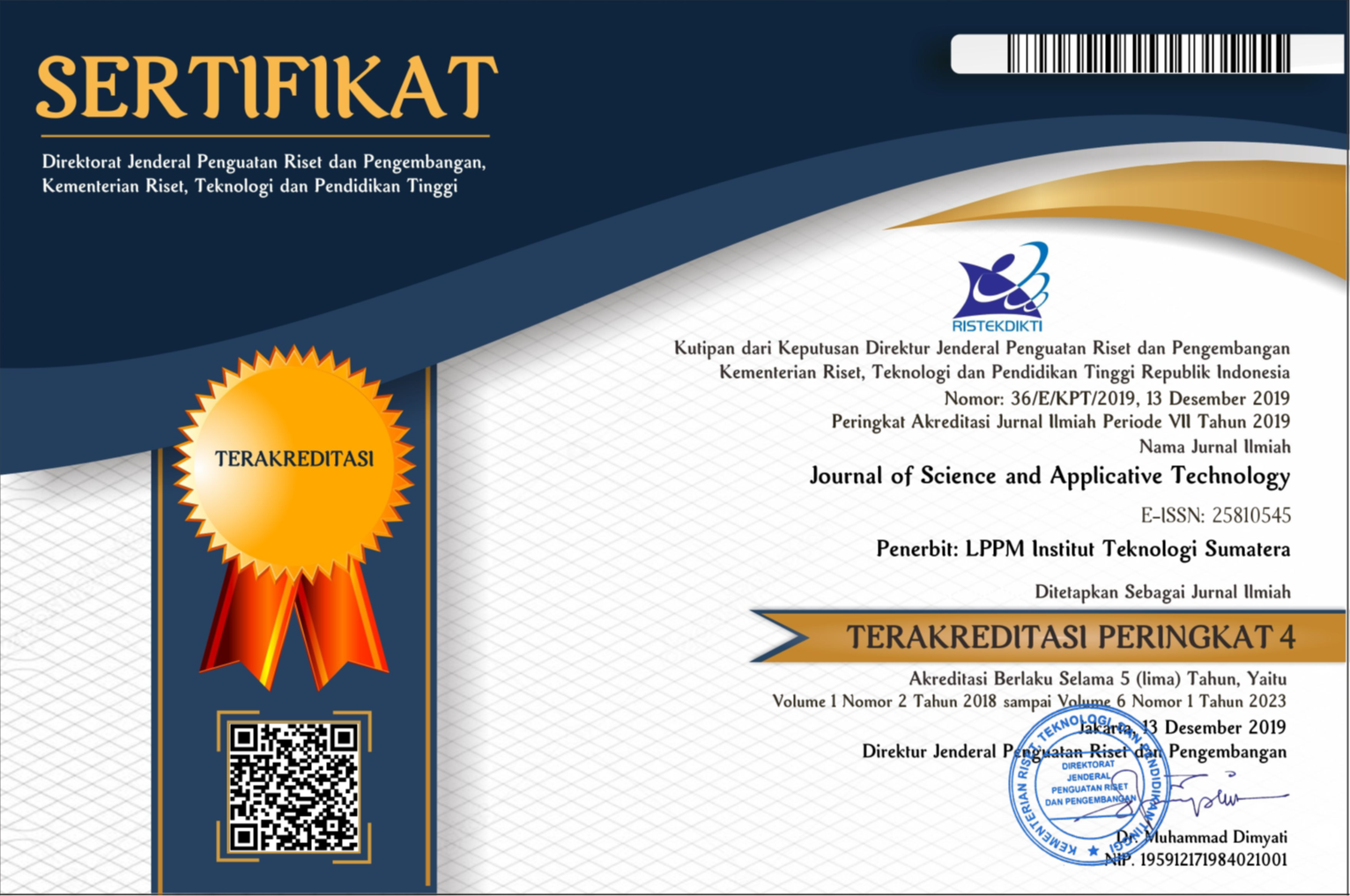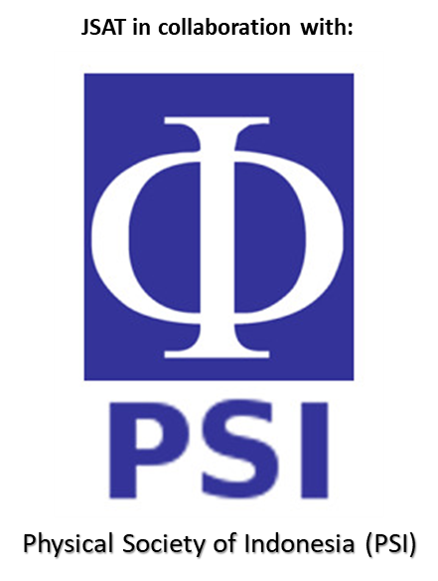Isolasi Nanoselulosa Terkarboksilasi dari Limbah Kulit Pisang Ambon Lumut dengan Metode Oksidasi
Abstract
In this study, banana peel from ambon lumut (Musa acuminata) was used as source for nanocellulose fibers. Carboxylated nanocellulose was isolated with oxidation method using ammonium persulfate (APS). In order to investigate the effect of temperature towards the characteristics of nonocellulose, temperature for oxidation process was set at three different values: 60 °C, 70 °C, dan 80 °C. Nanostructure of cellulose was observed as a mix of fibers and whiskers from transmission electron microscopy (TEM) images. The diameter of nanocellulose is ranging from 12,1 to 25,1 nm. Data from spectrometry graphs (FTIR) confirms the existence of carboxyl functional groups in nanocellulose samples. X-ray diffraction pattern (XRD) shows that crystallinity index values increase as temperature of oxidation process increases. The highest crytallinity index value of 72,4% was obtained from nanocellulose treated with oxidation temperature of 80 °C. This analysis shows banana peel waste as a potential alternative source for carboxylated nanocellulose.
Downloads
References
[2] “Produksi Pisang Menurut Provinsi, 2013-2017.†Badan Pusat Statistik dan Direktorat Jenderal Hortikultura, Accessed: Jan. 10, 2021. [Online]. Available: https://www.pertanian.go.id/Data5tahun/HortiATAP2017(.pdf)/Produksi%20Pisang.pdf.
[3] “Outlook Komoditas Pisang.†Pusat Data dan Sistem Informasi Pertanian, 2016, Accessed: Jan. 10, 2021. [Online]. Available: http://epublikasi.setjen.pertanian.go.id/arsip-outlook/76-outlook-hortikultura/424-outlook-pisang-2016.
[4] M. T. Postek, Ed., Production and applications of cellulose nanomaterials. Peachtree Corners, Ga: TAPPI Press, 2013.
[5] B. Deepa et al., “Structure, morphology and thermal characteristics of banana nano fibers obtained by steam explosion,†Bioresource Technology, vol. 102, no. 2, pp. 1988–1997, Jan. 2011, doi: 10.1016/j.biortech.2010.09.030.
[6] P. Khawas and S. C. Deka, “Isolation and characterization of cellulose nanofibers from culinary banana peel using high-intensity ultrasonication combined with chemical treatment,†Carbohydrate Polymers, vol. 137, pp. 608–616, Feb. 2016, doi: 10.1016/j.carbpol.2015.11.020.
[7] F. M. Pelissari, P. J. do A. Sobral, and F. C. Menegalli, “Isolation and characterization of cellulose nanofibers from banana peels,†Cellulose, vol. 21, no. 1, pp. 417–432, Feb. 2014, doi: 10.1007/s10570-013-0138-6.
[8] M. Börjesson and G. Westman, “Crystalline Nanocellulose — Preparation, Modification, and Properties,†in Cellulose - Fundamental Aspects and Current Trends, M. Poletto and H. L. Ornaghi, Eds. InTech, 2015.
[9] K. Zhang, P. Sun, H. Liu, S. Shang, J. Song, and D. Wang, “Extraction and comparison of carboxylated cellulose nanocrystals from bleached sugarcane bagasse pulp using two different oxidation methods,†Carbohydrate Polymers, vol. 138, pp. 237–243, Mar. 2016, doi: 10.1016/j.carbpol.2015.11.038.
[10] A. C. W. Leung et al., “Characteristics and Properties of Carboxylated Cellulose Nanocrystals Prepared from a Novel One-Step Procedure,†Small, vol. 7, no. 3, pp. 302–305, 2011, doi: https://doi.org/10.1002/smll.201001715.
[11] E. Lam et al., “Green Strategy Guided by Raman Spectroscopy for the Synthesis of Ammonium Carboxylated Nanocrystalline Cellulose and the Recovery of Byproducts,†ACS Sustainable Chem. Eng., vol. 1, no. 2, pp. 278–283, Feb. 2013, doi: 10.1021/sc3001367.
[12] R. V. Valmayor, International Network for Improvement of Banana and Plantain, and Asia and the Pacific Office, Banana cultivar names and synonyms in Southeast Asia. Los Baños, Philippines: INIBAP, Asia and the Pacific Office, 2000.
[13] L. Segal, J. J. Creely, A. E. Martin, and C. M. Conrad, “An Empirical Method for Estimating the Degree of Crystallinity of Native Cellulose Using the X-Ray Diffractometer,†Textile Research Journal, vol. 29, no. 10, pp. 786–794, Oct. 1959, doi: 10.1177/004051755902901003.
[14] A. Dufresne, J.-Y. Cavaillé, and M. R. Vignon, “Mechanical behavior of sheets prepared from sugar beet cellulose microfibrils,†Journal of Applied Polymer Science, vol. 64, no. 6, pp. 1185–1194, 1997, doi: https://doi.org/10.1002/(SICI)1097-4628(19970509)64:6<1185::AID-APP19>3.0.CO;2-V.
[15] B. Deepa et al., “Utilization of various lignocellulosic biomass for the production of nanocellulose: a comparative study,†Cellulose, vol. 22, no. 2, pp. 1075–1090, Apr. 2015, doi: 10.1007/s10570-015-0554-x.
[16] H. Tibolla, F. M. Pelissari, and F. C. Menegalli, “Cellulose nanofibers produced from banana peel by chemical and enzymatic treatment,†LWT - Food Science and Technology, vol. 59, no. 2, Part 2, pp. 1311–1318, Dec. 2014, doi: 10.1016/j.lwt.2014.04.011.
[17] J. Zhuang, M. Li, Y. Pu, A. Ragauskas, and C. Yoo, “Observation of Potential Contaminants in Processed Biomass Using Fourier Transform Infrared Spectroscopy,†Applied Sciences, vol. 10, no. 12, p. 4345, Jun. 2020, doi: 10.3390/app10124345.
[18] M. Cheng et al., “Efficient extraction of carboxylated spherical cellulose nanocrystals with narrow distribution through hydrolysis of lyocell fibers by using ammonium persulfate as an oxidant,†J. Mater. Chem. A, vol. 2, no. 1, pp. 251–258, Nov. 2013, doi: 10.1039/C3TA13653A.
[19] Y. Hu, L. Tang, Q. Lu, S. Wang, X. Chen, and B. Huang, “Preparation of cellulose nanocrystals and carboxylated cellulose nanocrystals from borer powder of bamboo,†Cellulose, vol. 21, no. 3, pp. 1611–1618, Jun. 2014, doi: 10.1007/s10570-014-0236-0.
[20] S. Elanthikkal, U. Gopalakrishnapanicker, S. Varghese, and J. T. Guthrie, “Cellulose microfibres produced from banana plant wastes: Isolation and characterization,†Carbohydrate Polymers, vol. 80, no. 3, pp. 852–859, May 2010, doi: 10.1016/j.carbpol.2009.12.043.
[21] B. M. Cherian, L. A. Pothan, T. Nguyen-Chung, G. Mennig, M. Kottaisamy, and S. Thomas, “A Novel Method for the Synthesis of Cellulose Nanofibril Whiskers from Banana Fibers and Characterization,†J. Agric. Food Chem., vol. 56, no. 14, pp. 5617–5627, Jul. 2008, doi: 10.1021/jf8003674.
[22] R. Zuluaga, J. L. Putaux, J. Cruz, J. Vélez, I. Mondragon, and P. Gañán, “Cellulose microfibrils from banana rachis: Effect of alkaline treatments on structural and morphological features,†Carbohydrate Polymers, vol. 76, no. 1, pp. 51–59, Mar. 2009, doi: 10.1016/j.carbpol.2008.09.024.
[23] M. F. Rosa et al., “Cellulose nanowhiskers from coconut husk fibers: Effect of preparation conditions on their thermal and morphological behavior,†Carbohydrate Polymers, vol. 81, no. 1, pp. 83–92, May 2010, doi: 10.1016/j.carbpol.2010.01.059
Copyright (c) 2021 Journal of Science and Applicative Technology

This work is licensed under a Creative Commons Attribution-NonCommercial 4.0 International License.
All the content on Journal of Science and Applicative Technology (JSAT) may be used under the terms of the Creative Commons Attribution-NonCommercial 4.0 International License.
You are free to:
- Share - copy and redistribute the material in any medium or format
- Adapt - remix, transform, and build upon the material
Under the following terms:
- Attribution - You must give appropriate credit, provide a link to the license, and indicate if changes were made. You may do so in any reasonable manner, but not in any way that suggests the licensor endorses you or your use.
- NonCommercial - You may not use the material for commercial purposes.
- No additional restrictions - You may not apply legal terms or technological measures that legally restrict others from doing anything the license permits.





















